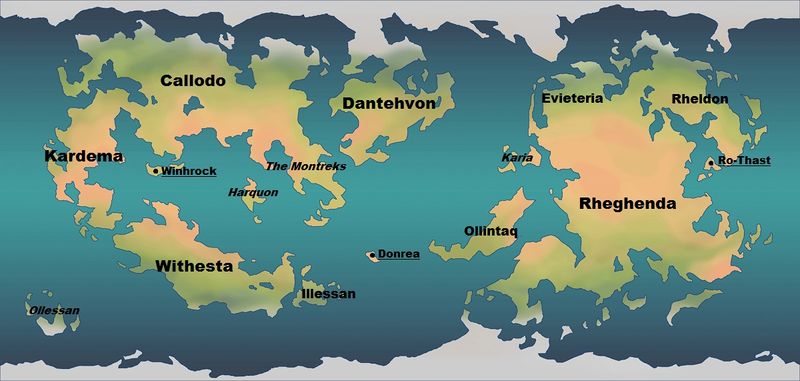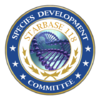Mathenite: Difference between revisions
(→Home World: Added Map) |
|||
| Line 64: | Line 64: | ||
*Faal | *Faal | ||
Faal is the collective term for the racial group of native peoples inhabiting Dantehvon, Evieteria, and The Montreks, though they are also the majority in Illessan, Karia, and Harquon, though these were former colonies of Dantehvian Empires. The Faal are the most divided in the way they organize themselves, though there is relatively little animosity between the individual groups of Dantehvon and Evieteria, an intense rivalry remains between the two regions. The people of the Montreks, descendants from the earliest Faal colonists in pre-historic times, and were often seen as 'lesser' by both their genetic cousins in Dantehvon and the native peoples of Callodo. They are a very divided people who have been trampled upon by multiple empires and there is a long history of ethnic conflict with strong religious connotations between the Montrek Peoples. | Faal is the collective term for the racial group of native peoples inhabiting Dantehvon, Evieteria, and The Montreks, though they are also the majority in Illessan, Karia, and Harquon, though these were former colonies of Dantehvian Empires. The Faal are the most divided in the way they organize themselves, though there is relatively little animosity between the individual groups of Dantehvon and Evieteria, an intense rivalry remains between the two regions. The people of the Montreks, descendants from the earliest Faal colonists in pre-historic times, and were often seen as 'lesser' by both their genetic cousins in Dantehvon and the native peoples of Callodo. They are a very divided people who have been trampled upon by multiple empires and there is a long history of ethnic conflict with strong religious connotations between the Montrek Peoples. | ||
The Faal have a wide range of light skin colors though most are some degree of tan, with pale skin being a rarity and only occurring in great numbers in northern Dantehvon. Their tan skin and light hair are what separate them physically from the peoples Rheldon and the northern desert peoples of Rheghenda. | |||
*Call | |||
The Peoples inhabiting the northern reaches of Callodo, the Call have chalk white skin, platinum white hair and narrow eyes, all adaptations to survive in their native environment that stretches from northern tundra, to verdant vales, and reaches into the arid costal plains west of the Montreks. The Call to the north have always been historically divided by either geography or minor tribal disagreements before coming together to form a vast Empire in northern Callodo. This Empire was the largest the Mathenites have ever seen, but it was also among the shortest since its success really rested on the shoulders of one man, Emperor Glaxius, a great tactical genius and worshiped as a God-King by some of the less-organized elements of the Call religion. The Empire collapsed shortly after his death, but the Empire in northern Callodo would survive and remain one of the most stable states in Mathenite history, if heavily divided by tribal distinctions. | |||
The Call inhabiting the south of Callodo, either in the Northern Montreks or the lands on the costal plains to the west of that, are ethnically different than their northern neighbors and have many cultural differences. The Southern Call are mariners and farmers both, and while this is characteristic of their northern cousins, the southern Call are far more organized and sophisticated, carving out small, but stable nations that have endured many centuries of peace and prosperity. The Southern Call also have some minor but widespread interbreeding with the Faal, and combined with their warmer climate, are usually a bit tanner than the northerners and their white hair as a slight gold tint to it. | |||
==Physiology== | ==Physiology== | ||
Revision as of 20:49, 20 December 2013
| Intelligent Lifeform Index |
|---|
| Mathenite | |
|---|---|
| Four Letter Code | MATH |
| Federation Status | Neutral |
| Planet of Origin | Unknown |
| Encountered | DS9: "Second Skin" |
| T/E Rating | T0/E0 |
| Current Tech Level | N, Unknown but space-faring |
| List of Named Mathenites | |

| |
Full ILI Gallery • Permitted Species Gallery | |
A neutral race who agree to provide asylum to Legate Ghemor after his rescue with Major Kira.
Home System
- Quadrant: Alpha
- Location: Tzen Poga Sector (A24-0003-1300 )
- Proper Name: Disputed
- Star: It orbits a class G (Yellow) star
- Distance from Star: it's orbit is approximately 158 million km
- Companions: 7 other planets. It is the 4th planet in the system
Home World
- Proper Name: Disputed (Most often used term is "Edghtan", though "Tanne" is considered the 'Politically Correct' term)
- Diameter: 12,749 km (7,968 miles)
- Gravity: 1.02 standard gravity with a density of 5.8
- Axial Tilt: 0.87%, no appreciable tilt and no seasons
- Orbital Period: 371 days
- Rotational Period: 26 hours
- Classification: M
- Surface Water: 68%
- Atmosphere: 1.07 is a standard pressure with 75% nitrogen, 24% oxygen, 1% trace chemicals
- Climate: Cool and stable, with the hottest temperatures being no higher than the Mediterranean on Earth.
- Population: 3.2 Billion
History
Introduction
A people long fractured and divided, even after achieving both First Contact and Warp Flight, the Mathenites unified under a single government forty years ago in the face of Cardassian aggression as they had done before, when faced with an external threat. Against all odds, what was supposed to be a temporary and weak alliance, was turned into a viable world government with a vision to turn the Mathenites into a single, unified people. However, just because this new government has the potential to unify the highly diverse tribes of the Mathenites, does not necessarily mean it can, or even will, as if faces strong backlash from various groups of people determined to hold on to their own unique identities and reject a singular, unifying Mathenite culture. Also a problem, are the interstellar colonies of the various nations that independently sent settlers out into space to colonize different nearby worlds, which were often split up between multiple nations. These far flung territories submitted to the Colonial Authority of the Confederacy both for their own protection and for greater economic opportunity, forming cohesive administrative blocs out of disparate lands made up of dozens of ethnic groups. Another question of their Imperialist policy concerns their settlements on worlds where intelligent life already existed in some cases, often at a much lower stage of advancement. The Mathenite Colonial Authority has, in the absence of direct power at home, decided to flex all of the political muscles it can elsewhere, and form the Colonies into cosmopolitan wonders, uplifting the 'lesser' races and unifying the Mathenite colonists for the common good. This blatant colonialism went unchecked in the region for centuries, and only now, after the discovery of the Bajoran Wormhole, conflicts with the Cardassians and the Dominion, and a new Federation Frontier opening up, has Starfleet and the Federation Council turned their eyes to the Mathenite situation. More specifically, the situation on the planet Nuradem, where Mathenite Colonialism is at its finest, and the complex situation of the colonists and natives threatens to involve not only the Federation, but the surrounding powers such as the Breen, Cardassians, and Tzenkethi.
Early History
Since Mathenites value telling the history of their own particular sub-culture or ethnic group, rather than that of their entire race in general, (Indeed it is debatable how many events are of racial importance other than conflicts such as wars and rivalries), any history of the species would have to tell the story of every individual group and how they relate (if at all). In an effort to condense the history of the Mathenites, one has to look at the broader trends of the various larger cultural blocs ( Like East versus West on Earth), rather than the individual histories of all the groups that encompass those larger categories.
Suffice to say though, modern Mathenites evolved on the eastern continent of their homeworld (Like the name of the planet, the name of the continent is also disputed but the 'correct' term is stated to be Rheghenda) where some crossed the narrow sea between the north-Western continent of Dantehvon, and others still island hopped from Dantehvon to the south-Western continent of Withestan. Across all three continents, the Mathenites created grand cities to form grand confederations of city-states and eventually nations, and then Empires, fueling their racial predilection for the pursuit of glory.
Government
The Confederacy
Still divided among many nation states on their Homeworld, the Mathenite Confederacy only has control over foreign policy, planetary and colonial defense, and the governance of the outlying colony worlds, essentially anything that does not concern the nations of the Homeworld, which it has next to no influence over, with all of its power resting with the states that support it. It has some economic controls but only between other interstellar governments, both corporations and the nation-states keep it that way.
The Confederate Parliament consists of a bi-cameral legislature, the Parliament of Peoples, and the Council of Executives. The Parliament of Peoples consists of 3 Representatives to each member state (Of which there are exactly 250) with a further 250 seats allocated to the Colonies based on proportional representation to their population. The Council of Executives is made up of 25 representatives divided into six regional territories representing the broadest possible division of the Mathenite Racial/Ethnic/Geographic groups. Five Seats are allocated to the Dantehvon-Northern Rheghenda, three seats are allocated to the Withestan-Eastern Islands, five seats are allocated to Callodo, two are allocated to Kardema, four are allocated to southern Rheghenda, and six are allocated to the colonies. The theme running through all political allocations resides in the state that the Mathenites were in forty years ago, the colonies happily submitted to the authority of the Confederacy while most of the nations were skeptical. The colonies provide the single largest voting bloc in both houses of Parliament, not a majority out right, but a heavily united front. It was hoped (And largely realized) that a strong colonial front would force the different states to find commonalities in their interests and band together, which has yielded mixed success since these alliances are mostly out of convenience and spread resentment among those Mathenites living on the homeworld that the colonies that they formerly ruled over, could have so much power.
The Colonies themselves though, must always submit to the ever almighty Colonial Authority, which controls every aspect of Colonial life. While the Colonies may have a great say in the actual workings of the Confederacy, they have little say in their own affairs at home. Colonials must also deal with an already extensive military presence that is steadily growing. The representatives for the colonies are also partly appointed, partly elected, with the Colonial members of the Council of Executives are chosen exclusively by the Colonial Authority, on a rotating basis.
The Confederacy itself is overseen by the Chairman who has broad, almost autocratic powers on extra-Homeworld affairs, but is near powerless when it comes to the nations that his authority fundamentally rests on. The Chairman is chosen from the ranks of the Parliament of the Peoples and
The Colonial Authority
Some would say a despotic regime, based on militarism and absolute power resting with Colonial Administrators, the Colonial Authority runs the different Mathenite colonies on 17 worlds (Some of which, are not even fully under Mathenite control), exercising the will of the Confederacy with an iron hand in one of the few arenas they can wield such power. The entire colonial leadership is unelected, with the only elected legislature with any real power residing on the Colony of Viseria, the rest of the colonial so-called 'Assemblies' merely have advisory powers. True authority rests with the 17 Colonial Administrators, which are more often than not, chosen from the ranks of the Mathenite homeworld population. They have broad and sweeping powers, and while many of the outlying colonies facing threat of border conflicts with alien or indigenous peoples welcome the security that the Colonial authority provides, some of the older colonies which have significant populations and established economies, do not like their rights being infringed upon by a far away homeworld. Those colonies with more 'Loyal' populations have more proportional representation in the Parliament of Peoples.
The Colonial Authority also has to deal with the 'problem' of the native populations on 8 different worlds, which are all vastly technologically inferior to the Mathenite Colonials. Some native species have completely submitted to Mathenite military and cultural hegemony, (Such as on Viseria, where the process of cultural assimilation and upliftion of the native species is in an advanced state) while others are either divided in their support or actively resist the CA. As stated before, some colonies do not even encompass entire planets, so border skirmishes between the colonials and the native people are also a problem, as is the problem of continued territory expansion to acquire resources and room to expand.
No where is the nuanced state of the CA's mission more evident than on Nuradem, the Mathenite colony closest to Federation space. On Nuradem, the Mathenites only control an area the size of South-East Asia on Earth, the rest being under the control of the native species, which is at a much lower level of technological advancement, many still living in huts and tribes. The situation is further complicated by the presence of the descendants of the first Mathenite colonists that no longer consider themselves "Mathenite", but rather Nurademian, though they also fight intermittent conflicts with the locals. Nuradem is considered the colony being watched by the entire Alpha Quadrant, with many parties interested in the colonial development for different reasons. The Mathenite authorities also face threats of terrorism from assimilated Nuradem natives who want the CA gone, and an ethnic conflict between a group of Nurademians that the Mathenite's arrival spared from genocide and have happily assimilated into Colonial life, and other allied Nurademians, who consider the other group 'unclean'.
Description
Mathenites are very similar to Humans, with a few minor aesthetic differences. Mathenites have pointed ears, longer fingers, a taller and thinner frame, slightly increased strength, and most of the population has light hair. Mathenites also (Like Humans) have many racial/ethnic groups that are largely split between cultural traditions, rather than skin tone or other physical features, but never the less, value their uniqueness when compared to other groups.
- Faal
Faal is the collective term for the racial group of native peoples inhabiting Dantehvon, Evieteria, and The Montreks, though they are also the majority in Illessan, Karia, and Harquon, though these were former colonies of Dantehvian Empires. The Faal are the most divided in the way they organize themselves, though there is relatively little animosity between the individual groups of Dantehvon and Evieteria, an intense rivalry remains between the two regions. The people of the Montreks, descendants from the earliest Faal colonists in pre-historic times, and were often seen as 'lesser' by both their genetic cousins in Dantehvon and the native peoples of Callodo. They are a very divided people who have been trampled upon by multiple empires and there is a long history of ethnic conflict with strong religious connotations between the Montrek Peoples.
The Faal have a wide range of light skin colors though most are some degree of tan, with pale skin being a rarity and only occurring in great numbers in northern Dantehvon. Their tan skin and light hair are what separate them physically from the peoples Rheldon and the northern desert peoples of Rheghenda.
- Call
The Peoples inhabiting the northern reaches of Callodo, the Call have chalk white skin, platinum white hair and narrow eyes, all adaptations to survive in their native environment that stretches from northern tundra, to verdant vales, and reaches into the arid costal plains west of the Montreks. The Call to the north have always been historically divided by either geography or minor tribal disagreements before coming together to form a vast Empire in northern Callodo. This Empire was the largest the Mathenites have ever seen, but it was also among the shortest since its success really rested on the shoulders of one man, Emperor Glaxius, a great tactical genius and worshiped as a God-King by some of the less-organized elements of the Call religion. The Empire collapsed shortly after his death, but the Empire in northern Callodo would survive and remain one of the most stable states in Mathenite history, if heavily divided by tribal distinctions.
The Call inhabiting the south of Callodo, either in the Northern Montreks or the lands on the costal plains to the west of that, are ethnically different than their northern neighbors and have many cultural differences. The Southern Call are mariners and farmers both, and while this is characteristic of their northern cousins, the southern Call are far more organized and sophisticated, carving out small, but stable nations that have endured many centuries of peace and prosperity. The Southern Call also have some minor but widespread interbreeding with the Faal, and combined with their warmer climate, are usually a bit tanner than the northerners and their white hair as a slight gold tint to it.
Physiology
Psychology
Religion
Mythology
Society
Culture
Customs
Technology
Economy
Military
Federation Intelligence Files
Sources
| SPECIES PROFILE UPDATED This profile was revised by the Species Development Committee. |
REV 239012.20 | |||
| Please add any new information discovered during the course of a mission or shore leave. | ||||
| SB118-SDC | ||||



